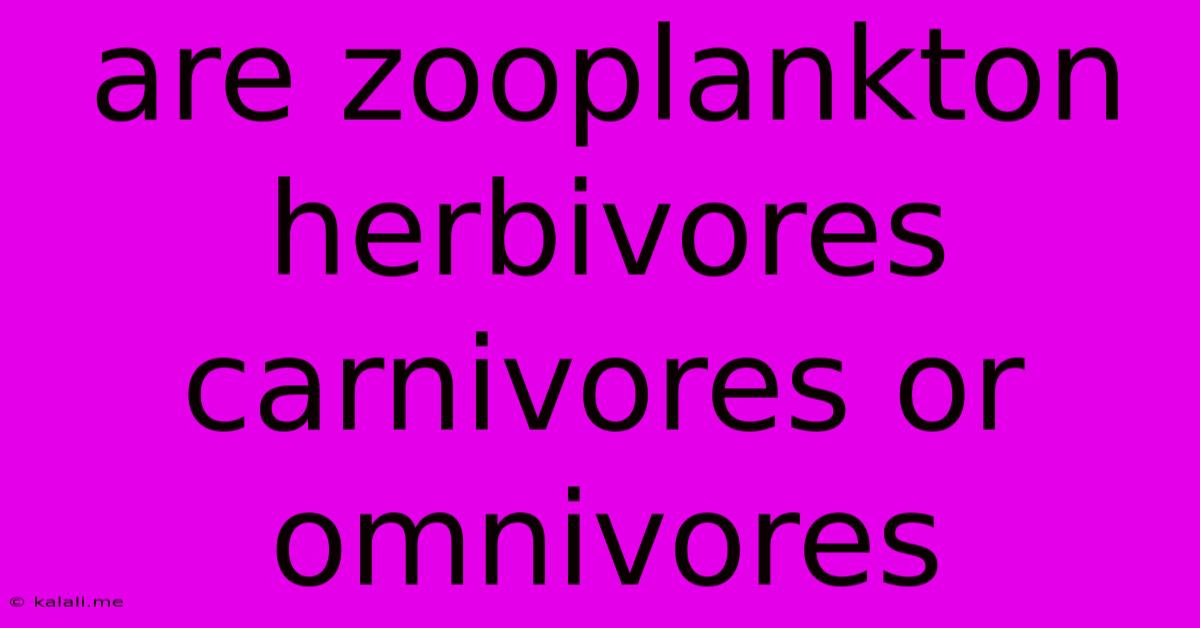Are Zooplankton Herbivores Carnivores Or Omnivores
Kalali
Jun 14, 2025 · 3 min read

Table of Contents
Are Zooplankton Herbivores, Carnivores, or Omnivores? A Deep Dive into Zooplankton Feeding Habits
Zooplankton, the tiny animals drifting in aquatic ecosystems, exhibit a remarkable diversity in their feeding habits. While often grouped together, their dietary preferences span a wide spectrum, blurring the lines between herbivore, carnivore, and omnivore classifications. This article delves into the complex world of zooplankton feeding, exploring the various trophic levels they occupy and the factors influencing their dietary choices.
Understanding Zooplankton Feeding Strategies
The classification of zooplankton as herbivores, carnivores, or omnivores depends primarily on their primary food source. However, many species are opportunistic feeders, adapting their diet based on food availability and life stage.
Herbivorous Zooplankton: The Plant-Eaters
Many zooplankton are herbivores, also known as primary consumers. These organisms feed directly on phytoplankton, the microscopic plants forming the base of most aquatic food webs. Examples include:
- Copepods: A highly diverse group, many copepod species graze on phytoplankton using specialized mouthparts.
- Daphnia (Water Fleas): These crustaceans are efficient filter feeders, consuming large quantities of phytoplankton.
- Rotifers: These microscopic animals utilize cilia to create currents that draw phytoplankton towards their mouths.
These herbivorous zooplankton play a crucial role in transferring energy from phytoplankton to higher trophic levels. Their grazing activity helps regulate phytoplankton populations and maintain the balance of the aquatic ecosystem. Their abundance often directly correlates with phytoplankton blooms.
Carnivorous Zooplankton: The Predators
Carnivorous zooplankton, also known as secondary consumers, prey on other zooplankton, including smaller herbivores or even other carnivores. This creates a complex food web within the zooplankton community. Examples include:
- Chaoborus (Phantom Midge Larvae): These ambush predators capture other zooplankton using specialized appendages.
- Some Copepod Species: Certain copepod species are actively predatory, feeding on other zooplankton or even small invertebrates.
- Larval Fish: While not strictly zooplankton, larval fish are often considered part of the zooplankton community and act as significant carnivores.
The predatory behavior of carnivorous zooplankton helps regulate zooplankton populations and influences the overall structure of the food web. The presence of effective predators can significantly impact the abundance of their prey.
Omnivorous Zooplankton: The Flexible Feeders
Many zooplankton species display omnivorous feeding habits, consuming both phytoplankton and other zooplankton. This dietary flexibility allows them to thrive in environments with varying food availability. The proportion of plant and animal matter in their diet can vary depending on factors like:
- Food Availability: If phytoplankton are scarce, omnivorous zooplankton may shift to consuming more zooplankton.
- Life Stage: Some species may exhibit different feeding strategies at different life stages.
- Environmental Conditions: Temperature and water quality can influence feeding preferences.
This opportunistic feeding strategy contributes to their ecological success and resilience in fluctuating environments. Their ability to switch between food sources enhances their survival chances.
Factors Influencing Zooplankton Diet
Several factors influence the dietary choices of zooplankton:
- Size and Morphology: Body size and the structure of feeding appendages determine the type of food a zooplankton can consume.
- Environmental Conditions: Water temperature, nutrient availability, and the presence of predators can all impact feeding behavior.
- Competition: Competition for food resources among different zooplankton species can shape dietary preferences.
Conclusion: A Diverse and Dynamic Trophic Role
In conclusion, the classification of zooplankton as strictly herbivores, carnivores, or omnivores is an oversimplification. Many species exhibit flexible feeding strategies, adapting their diets to optimize survival and reproductive success. Understanding the complex feeding interactions within zooplankton communities is essential for comprehending the dynamics of aquatic ecosystems. Further research continues to reveal the intricate relationships between zooplankton and their environment, highlighting the dynamic and multifaceted nature of their trophic roles.
Latest Posts
Latest Posts
-
Which Type Of Wave Has The Longest Wavelength
Jun 15, 2025
-
How Many Ias Officers Are Selected Every Year
Jun 15, 2025
-
Hockey World Cup 2024 Host Country
Jun 15, 2025
-
An Organism That Eats Another Organism
Jun 15, 2025
-
Which Em Wave Has The Longest Wavelength
Jun 15, 2025
Related Post
Thank you for visiting our website which covers about Are Zooplankton Herbivores Carnivores Or Omnivores . We hope the information provided has been useful to you. Feel free to contact us if you have any questions or need further assistance. See you next time and don't miss to bookmark.